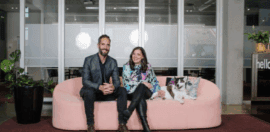How TACSI’s social R&D paper was inspired by biscuits

2 August 2021 at 4:58 pm
“People invest in new phones because there’s a market for new things that are seen to be better. I don’t think there’s the same appetite when it comes to social progress.”
The Australian Centre for Social Innovation’s chief innovation officer, Chris Vanstone, started his career in the UK designing biscuits. During that time he says he witnessed just how much research and development (R&D) work goes into getting each crispy, delicious mouthful 100 per cent perfect for the consumer.
After leaving the commercial world behind, Vanstone joined The Australian Centre for Social Innovation (TACSI), but as he started working with more complex social problems, he started to think about those biscuits again.
“I realised that some of the most rigorous R&D processes I had been part of were not when I was working on tough, social challenges with government and philanthropy,” Vanstone told Pro Bono News.
“It was when I was working in the commercial world designing biscuits. They had an 11-stage development process that involved chefs, marketers and product testing. And it’s just a biscuit!”
This epiphany helped prompt TACSI to begin working with a number of philanthropic partners to work out how to best contribute to the creation of long-standing social change. Culminating in a Social R&D white paper, published in July this year.
The team had spent months discussing the sense of despair they felt at the ongoing royal commissions and reforms that seemed to turn over the same topics, as demonstrated by a report from CSIA and the Centre of Social Impact which analysed 10 years of reforms in the community sector as a point of inspiration.
Read more: A decade of reviews with little social progress in between
“It found that we were always coming back to the same four things, there had been little progress,” Vanstone said.
“We are really stuck in a washing machine of reform.”
So the team started by asking themselves how they could take the research and development process used by other industries – where ideas, products and services are tested and researched – and use it to shift systems of reform and make a real change.
Social challenges as ideological issues
The process of research and development is easier to understand when the end result is something tangible like a product or service with a commercial value or even a groundbreaking event — like going to space — but using it to solve social challenges is a whole different ball game.
Vanstone thinks it’s because social challenges are often seen as ideological issues, and there’s little appreciation of the complexity of work that’s involved in the social problem-solving space.
“If you look at how we celebrate people like Elon Musk, there’s this idea that getting to space is some kind of social progress,” he said.
“It’s the same way we celebrate progress in digital technology. People invest in new phones because there’s a market for new things that are seen to be better. I don’t think there’s the same appetite when it comes to social progress.”
By looking at what social R&D looks like in Australia at the moment and the ways in which it can be improved, Vanstone hopes that people can get an idea of how to develop their own R&D process.
“There are currently some amazing things happening in Australia, particularly in the mental health space, but they are struggling to get their innovations funded, developed and happening,” he said.
“What we want to see happen is the same kind of dynamic we see in Silicon Valley, where if something is going to make money then money flows to it. I’m not saying that we should be funding exactly like that but we should have that same dynamic.”
Funding is something Vanstone mentions as being a challenge for the development of a social R&D process, as is the transparent sharing of information between organisations.
TACSI recently ran a network called the Social Innovation Learning Network, which brought together a number of innovation leads from different NFPs. Vanstone said they learned a lot.
“The participants said they felt that marketisation had gotten in the way of learning and knowledge. That’s not to say that we shouldn’t have marketisation but it’s more that [the way] it’s implemented, means that NFPs are very protective about what they’ve learned,” he said.
“It also means that a lot of R&D is being done by different organisations, which isn’t great value for money.”
Vanstone talks about the importance of sharing information when solving complex problems, using the COVID vaccine development process as an example.
“Genes were quickly sequenced and shared online so different agencies and scientists could share knowledge and results and an ecosystem was quickly built around this knowledge creation,” he said.
“That’s what’s missing in the social problem-solving space, there isn’t really an ecosystem built around knowledge creation.”
Where social R&D is working well
The inspiration behind TACSI’s work in this area, and its subsequent white paper, lies in Canada where they’ve successfully brought together practitioners from both NFP and government spaces. Once in the same room, they were able to talk about ideas and develop a shared understanding of how the R&D process would work.
“The work, to bring everyone together in one room, was initially philanthropically funded by the McConnell Foundation,” Vanstone said.
“Some of the people leading that work are now working in government roles and are focused on creating an R&D system within a particular field such as youth employment. They’re now trying to demonstrate what social R&D can look like in one situation, and I think that’s what it will take [to make social R&D successful].”
Connecting with leaders who see the potential in developing a social R&D process within their field or sector, much like they’re doing in Canada, is exactly what Vanstone, and TACSI, want to do in Australia.
“We want to work with leaders and play a role in facilitating conversations,” Vanstone said.
“We want to help them make sense [of their problem] and fill in any gaps in their thinking. We can then move towards some practical experimentation because it’s all doable.
“People have done it before. [R&D] isn’t rocket science but it does require a bit of thinking and a different way of working, and relating to each other as organisations.”
You can read the full white paper here.








